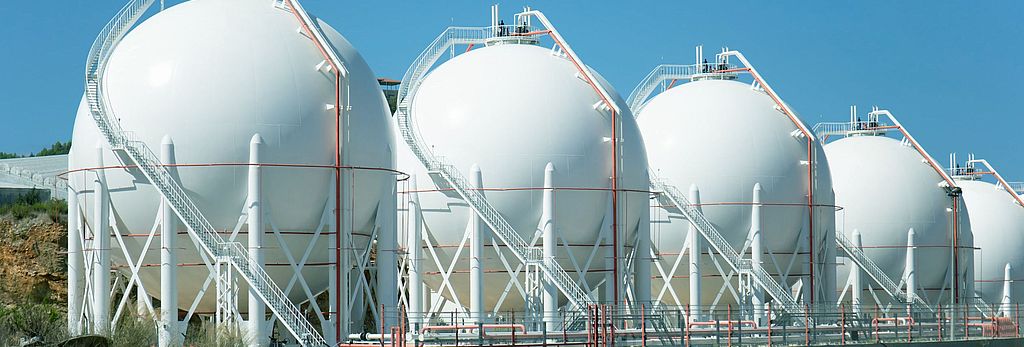
Natural gas (methane)
What is natural gas?
Natural gas is a combustible gas consisting mainly of highly flammable methane (CH4). It also contains nitrogen (N2) and small amounts of other hydrocarbons such as ethane, propane and butane, as well as traces of helium, and in some cases hydrogen sulfide. This fossil fuel is a combustion gas, a group which in addition to natural gas also includes hydrogen and refinery gases such as butane and propane (byproducts of oil refining).
What is natural gas used for?
Natural gas is mainly used to heat residential and commercial premises, and as a heat supply for thermal processes in trade and industry. However, it can also be converted into electricity and can be used to power natural-gas vehicles in compressed form as compressed natural gas (CNG), or as marine fuel or truck fuel in liquefied form as liquefied natural gas (LNG). In addition to its use as an energy carrier, natural gas is also used as a reactant in chemical processes such as ammonia synthesis in the Haber-Bosch process (nitrogen fertilizer), iron-ore reduction in the blast furnace process, and in the production of hydrogen.
Gas grades
The fuel is available in two grades, H or L gas (high or low), referring to the energy value of the gas. The gas quality a customer receives depends on the delivery area.
Calorific value of natural gas
The calorific value of natural gas is usually between 8.6 and 11.4 kWh per standard cubic meter (Nm3), based on a volume at 0°C and a pressure of 1013 mbar. By comparison, a liter of heating oil supplies about 10 kWh of energy.
How is natural gas produced?
Natural gas is produced through geochemical processes in organic material at great depths, from which it rises through cracks and pores in rock strata. If it encounters impermeable barriers on the way up, it forms underground gas deposits, also called natural gas traps. It frequently occurs in conjunction with crude oil and like crude oil is extracted, cleaned and dried via bores.
After processing, the natural gas or methane can also be fed into the natural gas grid, through which it is piped to various points of consumption.
Reserves of natural gas
The global reserves of natural gas are much more extensive than those of crude oil. The largest conventional gas reserves are in the Middle East. Exploiting them, however, requires heavy investment in additional major pipelines and liquefaction plants for transport purposes. In some regions such as the North Sea, the fossil fuel is already noticeably scarce, whereas volumes in North America have increased again due to the extraction of shale gas. However, Russia is the main source of natural gas in Europe.
Taxation of natural gas
The taxation of natural gas varies according to its use. In Germany fuels for heating purposes are taxed under the Energy Tax Act; in the German heating market, a tax rate of 0.55 cents/kWh applies for natural gas as a fuel.
Because its use is being encouraged for environmental and energy policy reasons, it is for the most part taxed below the rate of petroleum products that are used for the same purpose.
Mabanaft is active in trading, supply and project development for NGLs and their derivatives from our offices in London and Singapore via our business unit New Energy, Chemicals & Gas. Our Marketing business unit including the Petronord group are also active in trading gas.
Mabanaft business unit New Energy, Chemicals & Gas
Gases at Petronord
Status: December 2015
All information subject to change. Errors and omissions excepted.

